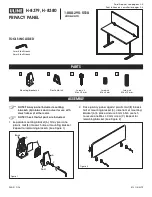
4
MN1620
4. Align the tapered bushing wedge keyway with the reducer hub
keyway. The keyway in the wedge is slightly wider than the
keyway in the reducer hub allowing for easier installation.
5. Install one bushing backup plate on the end of the hub and
secure with the supplied retaining ring. Repeat procedure for
other side.
6. Install the short bushing; flange first, on the driven shaft and
position per dimension “A”, as shown in Table 1. This will allow
the bolts to be threaded into the bushing for future bushing
and reducer removal.
7. Insert the output key in the shaft and bushing. For easy of
installation, rotate the driven shaft so that the shaft keyseat is
at the top position.
8. Mount the reducer on the driven shaft and align the shaft key
with the reducer hub keyway. Maintain the recommended
minimum distance “A” from the shaft bearing.
9. Insert the screws, with washers installed, in the unthreaded
holes in the bushing flange and align with the threaded holes
in the bushing backup plate. If necessary, rotate the bushing
backup plate to align with the bushing screws. Tighten the
screws lightly. If the reducer must be positioned closer than
dimension “A”, place the screws with washers installed, in the
unthreaded holes in the bushing before positioning reducer
making sure to maintain at least 3.0mm between the screw
heads and the bearing.
10. Place the long bushing in position on the shaft and align the
bushing keyway with the shaft key. Use care to locate the
long bushing with the tapered bushing wedge installed earlier.
Align the unthreaded holes in the bushing with the threaded
holes in the bushing backup plate. If necessary, rotate the
bushing backup plate to align with the bushing holes. Insert
bushing screws, with washers installed in the unthreaded
holes in the bushing. Tighten screws lightly.
11. Alternately and evenly tighten the screws in the bushing
nearest the equipment to the recommended torque given in
Table 1. Repeat procedure on outer bushing.
Straight Bore Reducer Installation
1. Install reducer on the driven shaft as close to the equipment
as practical.
2. It is not necessary for the shaft to extend through the full
length of the bore. Minimum shaft lengths are provided in
Table 1. It is preferred that both retaining collars are used;
however, if shaft length will not permit the use of both
retaining collars, one collar is sufficient for locking the reducer
onto the shaft.
3. Tighten the set screws provided in each retaining collar. If
the outer retaining collar is not being used, remove from the
reducer to avoid retaining collar from dislodging and jamming
the reducer during operation.
Bushing Removal - Standard Taper or Short Shaft
Bushings
1. Remove bushing screws.
2. Place the screws in the threaded holes provided in the
bushing flanges. Tighten the screws alternately and evenly
until the bushings are free on the shaft. For ease of tightening
screws make sure screw threads and threaded holes in the
bushing flanges are clean. If the reducer was positioned
closer than the recommended minimum distance “A” as
shown in Table 1, loosen the inboard bushing screws until
they are clear of the bushing flange by 3.0mm. Locate two
(2) wedges at 180 degrees between the bushing flange and
the bushing backup plate. Drive the wedges alternately and
evenly until the bushing is free on the shaft.
3. Remove the outside bushing, the reducer, and then the
inboard bushing.
Straight Bore Reducer Removal
1. Loosen screws in retaining collars as applicable.
2. If both retaining collars are installed, remove the outer
retaining collar. This will expose three puller holes in the
output hub.
3. Install a three-jaw puller and remove reducer from shaft.
Use caution not to damage the output hub during reducer
removal.
Figure 6 - Short Shaft Bushing &
Output Hub Assembly
Содержание Ratios 15
Страница 31: ...31 MN1620...





































